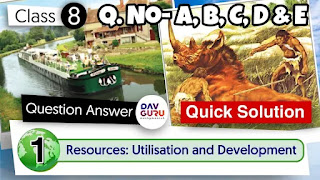All the available study materials for this chapter are listed below. Watch, download, and start studying!
Watch All Videos of This Chapter from PLAYLIST
A. Tick the correct option.
1. Future generations will depend on solar energy because it is–
(a) biotic
(b) man-made
(c) Inexhaustible ✅
(d) non-renewable
2. Which one of the following resources can be recycled?
(a) gold ✅
(b) coal
(c) land
(d) natural gas
3. All the abiotic resources include–
(a) living beings
(b) non-living things ✅
(c) inexhaustinle resources
(d) renewable resources
4. Available resources which are not being tapped fully for the time being are called–
(a) actual resources
(b) man-made resources
(c) biotic resources
(d) potential resources ✅
5. Which one does not promote conservation of resources?
(a) use resources more efficiently
(b) optumum utilisationn of resources
(c) Use as much resources as required ✅
(d) reduce wastage of resources.
B. Fill in the blanks.
1. Metals can be used again and again after processing.
2. On the basis of occurrence, resources are classified into two categories natural and man-made.
3. With advancement of technology, availability of capital and skilled labour are necessary for resource utilisation.
4. Developed countries are economically self-sufficient and technologically advanced.
5. The potential resources need a detailed survey for estimating their quantity and quality.
C. Write a technical term or an appropriate word for each of the following statements.
1. Any material which is used to satisfy human needs: Resources
2. Resources which cannot be renewed: Non-renewable
3. Resources which are created by human beings: Man-made
4. The resources which are surveyed and developed: Actual
5. Sustainable and optimum utilisation of resources: Conservation
D. Answer the following questions in brief.
1. ‘Utility and value of a resource vary from time to time and place to place.’ Give any three examples.
Answer: The three examples are given below-
a) The value of river water was once mostly for farming, but now it is also used for electricity and industry.
b) Wind has become useful in modern times for generating energy.
c) Even sand, once ignored, is now used in making glass and buildings.Answer: Humans are important because they have the knowledge and skills to use natural resources wisely and turn them into useful things for development.
Answer:
Answer:
Biotic resources are living things like animals and plants.
Abiotic resources are non-living things like water, air, and minerals.
4. Why is there a need for resource planning? Give any three reasons.
Answer: Resource planning is needed to avoid wastage, to use resources properly, and to make sure all areas get equal access to them.
5. Mention any six factors on which the utilisation of resources depends.
Answer: The use of resources depends on availablility of resources, human skill, capital or money, technology, transport, and water availability.
E. Answer the following questions.
1. ‘Human needs and wants are neither uniform in all parts of the world nor static over the years.’ Explain the statement giving suitable examples.
Answer:
Human needs and wants are different in different parts of the world. They also change over time depending on progress and development.
In ancient times, people only needed food, clothes, and shelter, which they got directly from nature. Today, in modern society, people need vehicles, gadgets, electricity, internet, and more.
These needs grow with lifestyle changes, population growth, and technological advancement.2. Distinguish between renewable and non-renewable resources. Which one of the two would you prefer to use and why?
Answer:
Renewable resources can be reused or replaced naturally or through human effort. Example: Solar energy, wind energy, water, forests.
Non-renewable resources cannot be replaced once used up. Example: Coal, petroleum, natural gas.
I would prefer renewable resources because:
They are available in nature again and again. They are environment-friendly. They reduce pollution and can be used for a long time. They help conserve non-renewable resources for future generations.3. What is meant by sustainable development? Why is sustainable development the need of the hour?
Answer: Sustainable development means using resources without harming the environment. It ensures that present needs are fulfilled without affecting the needs of future generations.
It is important because m
any resources are limited and getting overused. Overuse causes problems like pollution and shortage. It helps maintain balance between development and conservation. It protects nature and supports life for the long term.4. Describe the various basis of classification of resources with the help of examples.
Answer: Resources are classified in the following ways:
a) On the basis of exhaustibility:Renewable: Can be used again (e.g. sunlight, water, air).
Non-renewable: Cannot be replaced once used (e.g. coal, petrol).
Biotic: Living things (e.g. plants, animals).
Abiotic: Non-living things (e.g. land, water, minerals).
Natural: Found in nature (e.g. rivers, soil).
Man-made: Created by humans (e.g. roads, machines).
Potential: Present but not used yet (e.g. uranium in Ladakh).
Actual: Already in use (e.g. black soil in Maharashtra).

